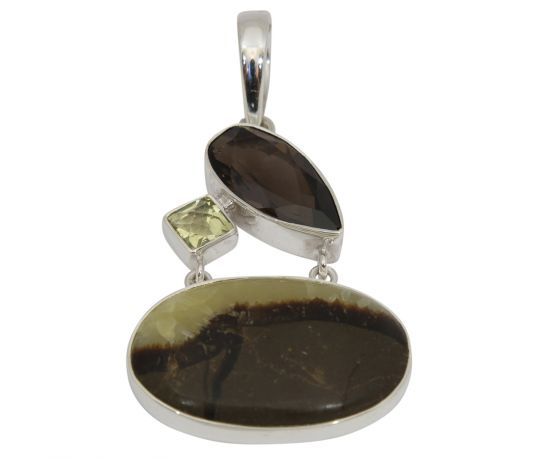We use cookies to make your experience better.
Septoria, citrine and smoky quartz pendant in silver 925/000. Unique & single copy
Sepataria is the Key for Purity and Confidence. The Septoria is a kind of Calcite variety. The Septoria is instantly recognizable by its brown color with its wonderful inclusions, often star-shaped. Repositories of Septoria are Utah, Arizona and Madagaskar.Sepatria is a spherical or oval shape isolated from formations of sedimentary rocks. Sepataria Concretions are closely tubers. Tubers have a rounded structure and come individually. One concretion the other hand, is usually a mass of a number of tubers. Septoria Concretions caused by diagenesis, a process in which heat and pressure change of a rock, but not as large as metamorphosis. Most concretions occur in limestone and chalk. Also clay-ironstone is a rich source of concretions. It may happen that some concretions come to the surface (outcrop). These concretions may have formed fossils, which are well preserved by the diagenesis. Besides fossils are found sometimes agate back. Septoria is also known as the Dragon Stone.
Citrine or lemon quartz is the lemon yellow translucent variant of the mineral quartz (SiO2). Features Like other varieties of quartz, is a translucent citrine nesosilicaat. The yellow color is caused by trace elements, whereby in particular divalent and trivalent iron plays a role. The crystal system of istrigonal citrine and the hardness is 7. Name: The name is derived from citrus citrine (due to the yellow color). The fourth variety was, depending on the color, in the past also called Madeira topaz, gold topaz or topaz Bahía called entirely unjustified since topaz is an entirely different mineral. Probably this happened to suggest a higher preciousness. Appearance: The main sites of citrine are Brazil, Madagascar and the former Soviet Union. Amethyst is often roasted and sold as citrine. This can be identified by brown to black spots. Citrine is more valuable than Amethyst.
Smoky quartz is a quartz variety. The smoke color is brown to almost black, translucent. Very dark variants are called morion. Smoky Quartz is most common in cavities in intrusiegesteenten and high-grade metamorphic rocks. In sedimentary rocks and extrusive is smoky quartz rare. Sites in include the Alps, Brazil, Russia, Mexico, India, Ireland, Zimbabwe, Afghanistan and US The color of smoky quartz is caused by aluminum in the crystal lattice, in combination with ionizing radiation. The aluminum to replace the silicon in the crystal structure in which the complex [AlO4-] is formed in lieu of [SiO4]. For example, the resulting charge difference to compensate for times there is the growth of the crystal at the same time small monovalent cation of hydrogen, lithium or sodium incorporated into the crystal structure. Under the influence of ionizing radiation, the electron moves from the [AlO4 -] - are complex to a cation, and creates a color center. This process occurs normally only below 50 ° C. At higher temperatures, the decomposition of the color centers place more rapidly than the production thereof. The source of the ionizing radiation is usually potassium-40, the surrounding rock. So the color of smoky quartz occurs long after the crystals are formed and can take several million years, this is also the reason most cairngorms in veldspaatrijke rocks such as granite genesis. When heated above 200 ° C will smoky quartz lose its color. Irradiating clear quartz (rock crystal) with X-rays or gamma radiation produces almost always in smoky quartz. The method is then also used to make of colorless quartz smoky quartz. In ancient times this stone warned the soldiers in battle as he darkly colored. Smoky Quartz is still used for rosaries and crucifixes now. Some medicinal effects is awarded to smoky quartz; it would help prevent digestive problems, stress, grief and help a child. According to various literature belongs to the mineral in the constellation Libra.












